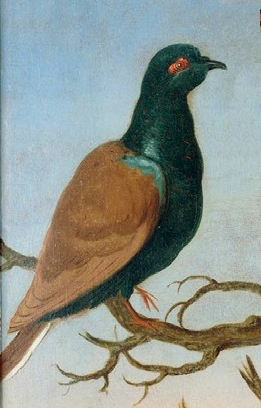São Tomé green pigeon
| São Tomé green pigeon | |
|---|---|

| |
| Illustration by Albert Eckhout | |
| Scientific classification | |
| Domain: | Eukaryota |
| Kingdom: | Animalia |
| Phylum: | Chordata |
| Class: | Aves |
| Order: | Columbiformes |
| Family: | Columbidae |
| Genus: | Treron |
| Species: | T. sanctithomae
|
| Binomial name | |
| Treron sanctithomae (Gmelin, JF, 1789)
| |
The São Tomé green pigeon (Treron sanctithomae) is a species of bird in the family Columbidae. It is endemic to the island of São Tomé in São Tomé and Príncipe. Its natural habitat is subtropical or tropical moist lowland forests. The species was described by Johann Friedrich Gmelin in 1789. They have disappeared from Ilhéu das Rolas due to habitat loss. There are between 37,007-109,255 pigeons of this species today,[1] but this is decreasing due to unsustainable levels of hunting.[2]
Taxonomy
[edit]The São Tomé green pigeon was described by German naturalist Georg Marcgrave in 1648 and the English ornithologist Francis Willughby in 1678.[3][4] When the German naturalist Johann Friedrich Gmelin revised and expanded Carl Linnaeus's Systema Naturae in 1789 he chose to include the São Tomé green pigeon. He placed it with all the other doves and pigeons in the genus Columba and coined the binomial name Columba sanctithomae.[5] The São Tomé green pigeon is now placed with around 30 other green pigeons in the genus Treron that was introduced in 1816 by the French ornithologist Louis Pierre Vieillot.[6][7] The genus name is from the Ancient Greek trērōn meaning "pigeon" or "dove". The specific epithet sanctithomae is from Late Latin sanctus meaning "saint" and Thomae for "Thomas".[8] The species is monotypic as no subspecies are recognised.[7]
References
[edit]- ^ a b BirdLife International. (2021). "Treron sanctithomae". IUCN Red List of Threatened Species. 2021: e.T22691227A176255708. doi:10.2305/IUCN.UK.2021-3.RLTS.T22691227A176255708.en. Retrieved 15 November 2021.
- ^ Carvalho, M.B. (2015). Hunting and Conservation of Forest Pigeons in São Tomé (West Africa) (PhD thesis). Universidade de Lisboa.
- ^ Marcgrave, Georg (1648). Historia Naturalis Brasiliae: Liber Quintus: Qui agit de Avibus (in Latin). Lugdun and Batavorum (London and Leiden): Franciscum Hackium and Elzevirium. p. 213.
- ^ Willughby, Francis (1678). Ray, John (ed.). The Ornithology of Francis Willughby of Middleton in the County of Warwick. London: John Martyn. p. 183.
- ^ Gmelin, Johann Friedrich (1789). Systema naturae per regna tria naturae : secundum classes, ordines, genera, species, cum characteribus, differentiis, synonymis, locis (in Latin). Vol. 1, Part 2 (13th ed.). Lipsiae [Leipzig]: Georg. Emanuel. Beer. p. 778.
- ^ Vieillot, Louis Pierre (1816). Analyse d'une Nouvelle Ornithologie Élémentaire (in French). Paris: Deterville/self. p. 49.
- ^ a b Gill, Frank; Donsker, David; Rasmussen, Pamela, eds. (January 2022). "Pigeons". IOC World Bird List Version 12.1. International Ornithologists' Union. Retrieved 22 August 2022.
- ^ Jobling, James A. (2010). The Helm Dictionary of Scientific Bird Names. London: Christopher Helm. pp. 389, 346-347. ISBN 978-1-4081-2501-4.
